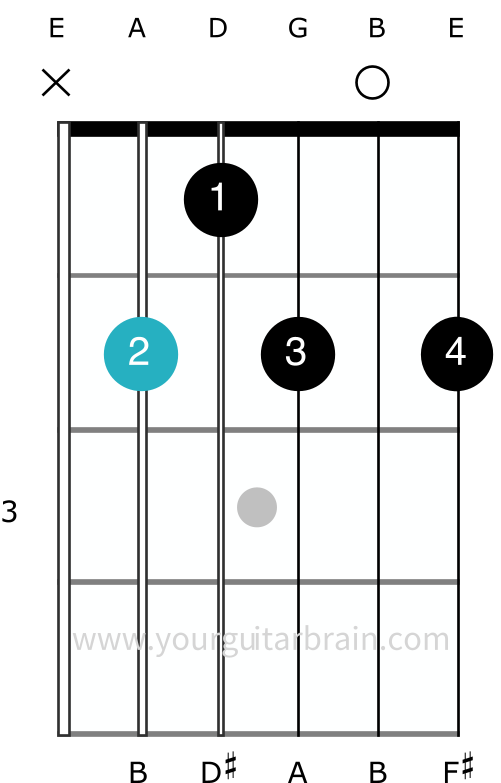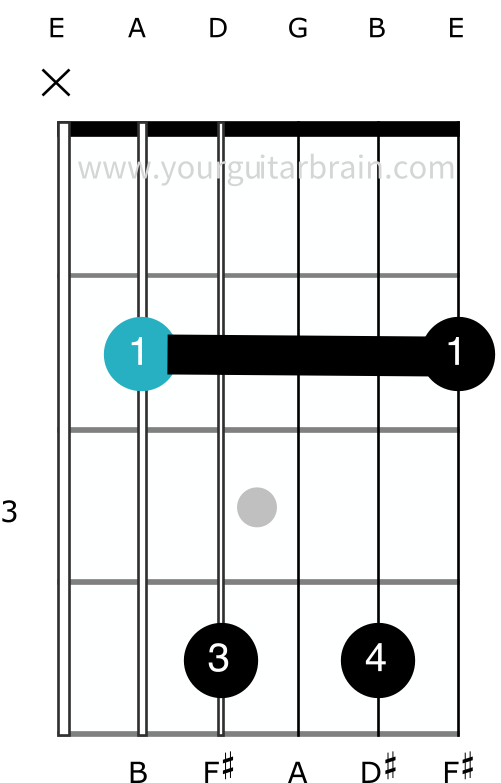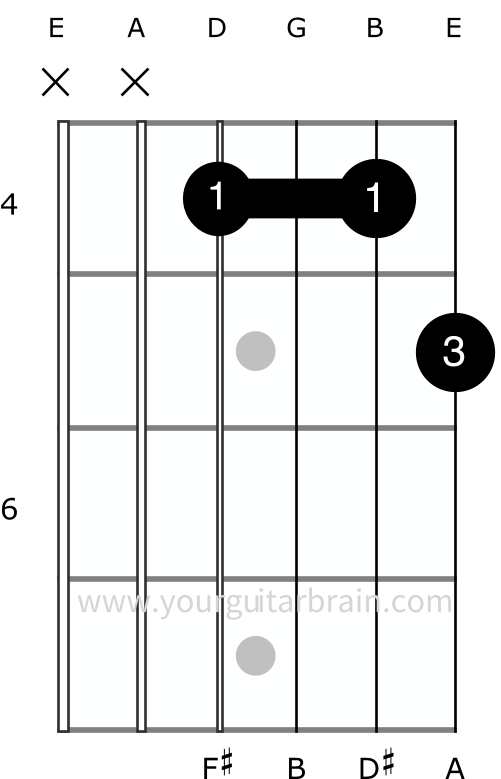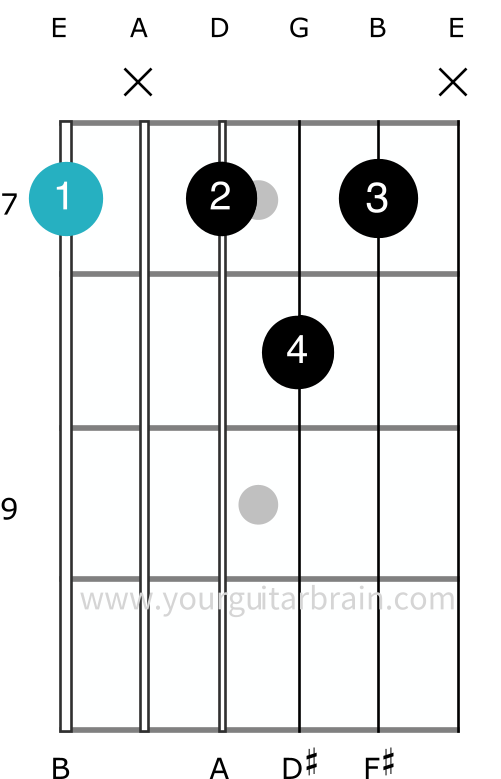Learn how to play the B dominant 7th guitar chord with easy variations for beginners and practice tips to help you totally boss that B7!
In this article, you’re going to learn how to play the B7 chord on the guitar. We’ve got five variation shapes and practice tips that’ll help you master the chord in lickety-split time.
B7 Really Means B Dominant 7
The B7 chord shares the same three notes as a B Major chord, plus an extra seventh note (b7) added on for good measure. We call this a minor seventh interval.
B7 is actually a shorthand way of writing “B dominant seventh”. It’s become standard for musicians to drop the word “dominant” when talking about this type of chord, which I don’t think is particularly helpful for beginner players.
Why? Because there are different types of seventh chords out there, such as Major seventh (e.g. BMaj7) and minor seventh (e.g. Bmin7). Consequently, it often leads to confusion when we don’t specify the seventh chord quality (aka type).
Music Styles That Use Dominant 7th Chords
The characteristic-sounding dominant seventh chord is used in many different music styles. To name a few; Blues, Country and folk.
Though nowhere near as popular as Major and minor chords, you won’t go long before you want to learn a song that has a chord such as B7, C7 or G7 in it.
B7 Chord Notations
B7 | B dom 7 | B dominant 7th | B dominant seventh
B7 Chord Theory Facts x 5
- The B dominant 7th chord contains the notes: B – D# – F# – A. These notes repeat all over the guitar fretboard, which means we can play B7 using assorted shapes and voicings along the neck.
- The B7 chord is typically built on the fifth degree (note) of a Major scale. For example, B is the fifth note of the E Major scale, so the specific dominant seventh chord built from this key is B7. (Refer here for more help understanding basic music theory.)
- The B7 chord formula is: 1 – b3 – 5 – b7.
- The intervals of a dominant seventh chord are root > Major third > perfect fifth > minor seventh.
- In blues, B7 often appears in the i – IV – V chord progression in the key of E Major: E7-A7-B7.
Having said all that, it’s time for us to get to the B7 chord diagrams.
Good to Know
I show the best fingerings in the finger position circles in the chord diagrams below. The chord notes are shown below the boxes with the B root highlighted in blue.
Shape 1 – The Popular Open B7 Shape
You know how usually the ‘proper’ way to play a chord is a barre shape? You’ll be happy as a clam to hear that this isn’t the case with the B dominant seventh chord.
This first B7 chord shape requires no barre and can even be broken down to make it easier as you build up your finger strength. Have a look:
Open B7 chord shape
Here are the finger positions:
- First (index) finger – 1st fret of the D (4th) string
- Second (middle) finger – 2nd fret of the A (5th) string
- Third (ring) finger – 2nd fret of the G (3rd) string
- Pinky (fourth) finger – 2nd fret of the top E (1st) string
In this B7 shape, you play strings 5-1 and mute the low E string. This is easy to do when you wrap your thumb around the neck and lightly touch the string.
Top Tip: If you’re a beginner, wrapping your thumb around to mute the low E string may feel like a task. Don’t jump the gun and think it’s impossible to do. Practise and be patient.
It takes time for the many areas in your brain to adapt and change when perfecting a new skill, like learning a new chord. You’ll get there.
With that out the way, next, we have an easier variation of this chord shape that doesn’t include the pinky. Use this as a stepping stone towards playing the full four-fingered shape.
Shape 2 – The Open B7 Shape (Without The Pinky)
Here’s an alternative chord voicing for the open B7 chord. It’s not strictly a full dominant seventh chord because it leaves out the perfect 5th (F#) note.
It still has the first (B), third (D#) and seventh (A), though, so it sounds similar enough:
Open B7 chord shape without the pinky
Use the same fingers you used for the previous shape minus the pinky. Be sure to only play the middle four strings. If you play either of the E strings, the E note will clash.
With that being considered, let’s examine the next way to play a B7 chord.
Shape 3 – B7 “A Shape” Barre Chord
This B dominant 7th chord shape is built using the open A7 chord shape.
All we do is form a barre with our first finger and move up the fretboard till we play the B root note on the 2nd fret of the A string:
B7 guitar chord using the A7 shape
Finger placements:
- First (index) finger – 2nd fret of the A (5th) string & barre across strings 5-1
- Third (ring) finger – 4th fret of the D (4th) string
- Pinky (fourth) – 4th fret of the G (3rd) string
As always, with barre chords that don’t include the 6th string, make sure you don’t put your finger on top of it. This will only make the barre harder to play and is incorrect.
Top Tip: If you find the strings are buzzing under your first finger (which they will do at first), squash your second finger onto it. This helps you get more pressure.
Shape 4 – 2-Finger B7 Chord Variation
This B7 chord voicing is a lush sounding way to play a dominant 7th chord. It’s also a movable shape, so you can play any pitch dominant seventh chord using the same shape.
If you’re unsure what a movable chord means, it’s time to brush up on your basic music theory.
2-finger B7 chord variation
The B root note is found on the fourth fret of the G string. Because it isn’t in the lowest position, we call this a chord inversion. This shape, with its higher pitch notes, will sound at home played in a funk song.
- First (index) finger – 4th fret of the D (4th) string & barre strings 4, 3 and 2
- Third (ring) – 5th fret of the high E (1st) string
Shape 5 – B7 Chord Alternative
This final B7 chord variation has the B root note on the 7th fret of the low E string:
Bm Chord – “D Shape”
Finger placements:
- First (index) finger – 7th fret of the low E (6th) string
- Second (middle) finger – 7th fret of the D (4th) string
- Third (ring) finger – 7th fret of the top B (2nd) string
- Pinky (fourth) – 8th fret of the G (3rd) string
Top Tip: Mute the A and top E strings by touching them with the adjacent fretting fingers. This takes practice as you need to get the right amount of curve on your fingers. It’s all about finding that sweet spot.
This lower pitch B7 shape variation will sound great played in a song or chord progression where the mood you want to convey is darker. Think rock or metal as a generalised example.
In Summary
That being that, now you have five different ways to play a B7 chord on your guitar. Be sure to check out our other essential chord guides before you toddle off:
How To Nail The F-ing F Chord
How To Play The B Major Guitar Chord
How to Play the Bm Guitar Chord
















